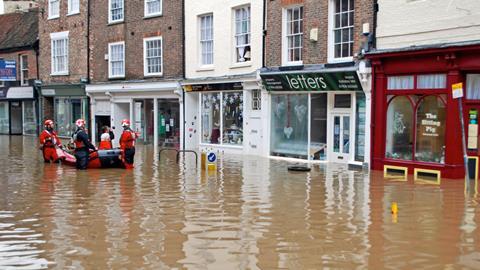Government’s infrastructure advisors said £12bn of drainage network upgrades needed over next 30 years to tackle extreme weather caused by climate change
New laws to stop developments connecting to existing drainage networks are needed to stop more than half a million homes from flooding, the government’s infrastructure advisors have said.
The National Infrastructure Commission (NIC) also called on ministers to set aside £12bn in funding over the next 30 years to upgrade drainage systems so that buildings are protected from extreme weather caused by climate change.
There are currently 325,000 properties in England in areas at high risk from flooding, which means they have a 60% chance of being flooded in the next three decades.

But in a new report published today, the NIC said increasing pressure on drainage systems caused by new developments could push an additional 230,000 properties into the high risk category.
The use of impermeable surfaces such as paved over gardens could put another 65,000 buildings at risk, according to the report.
It urged ministers to strengthen legislation and standards to discourage new developments from connecting to existing drainage infrastructure and control the spread of impermeable surfaces.
A 30-year programme of upgrades to existing drainage infrastructure, funded by public and private investment, would also be needed, with priority given to sustainable above-ground drainage systems such as channels and drains over new pipes and sewers.
The report also called for greater use of nature-based solutions such as roof gardens, rain gardens and drainage ponds, and said the Environment Agency and Ofwat, the water services regulator, should have bigger roles in assessing flood risks.
NIC commissioner Jim Hall said the urban spread and the increasing intensity of downpours showed the risks of flooding needed to be taken “far more seriously”.
“The solution is clear – reducing the amount of water flowing into drains, whilst also improving the capacity of those drains.
“That means stopping urban creep from increasing the amount of stormwater that drainage systems have to cope with and giving nature more opportunities to hold on to excess water, as well as targeted investment to ensure sewers can cope with growing pressures.
“While sustained investment is needed, the estimated additional costs are relatively modest. At least as important is a more joined-up approach to owning and acting on the problem.”
See also>> How do we protect our homes from surface water flooding?
The Met Office warned earlier this month of the risk of severe flooding this winter due to a global weather phenomenon called La Niña, which is expected to cause heavier rains in February.
Localised floods across England last month and a series of major flooding incidents in London last year have put a spotlight on the risks posed by surface water flooding, the NIC said.
But the body said the £12bn estimated cost of dealing with the issue could be reduced if the right actions are taken by the government in spending £56bn already earmarked for reducing sewer overflows over a 25-year period from 2025.
The Storm Overflows Discharge Reduction Plan is designed to lead to an 80% reduction in the number of annual spills by 2050.
The NIC report’s three recommendations:
- Reduce the amount of run-off water entering drainage systems – government should strengthen legislation and standards to discourage new developments from connecting to existing drainage infrastructure in favour of wider uptake of sustainable systems, and review options for managing the unplanned growth of impermeable surfaces.
- Expand the capacity of drainage systems – better maintenance of existing drainage networks and expanding the use of lower cost above ground measures (such as channels and drains) should be considered before new pipes and sewers, and priority should be given to nature-based solutions such as roof gardens, drainage ponds and rain gardens. Ofwat should ensure that water and sewerage companies play their part, by enabling efficient investment in both above and below ground drainage infrastructure.
- Create more joined-up, targeted governance and funding - the Environment Agency should be actively involved in assessing surface water flood risk and government should set national risk reduction targets. Local authorities and water companies should then work together to develop fully costed joint plans which deliver locally agreed targets, with public funding devolved to local areas.




























No comments yet